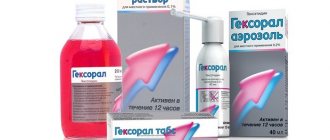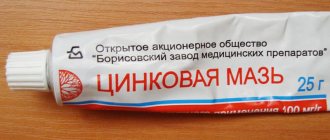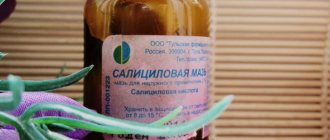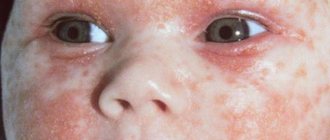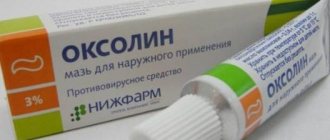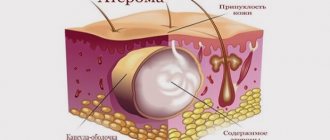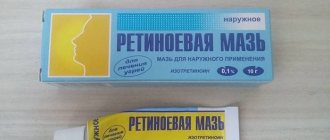Detailed instructions for the use of Miramistin in the form of a spray, ointment and solution for children and adults. Presented in a form accessible to readers.
Miramistin is one of the best modern antiseptics, produced in three forms: ointment, solution, spray. The drug is able to resist various types of pathogens: pathogenic viruses, yeast-like fungi, bacteria, pathogens of gonorrhea, syphilis, chlamydia, as well as protozoa.
Miramistin contains a special formula that penetrates under the membranes of microorganisms and disrupts the integrity, as a result of which the microbes die. At the same time, Miramistin is absolutely safe and even beneficial for the human body: the active substance of the drug restores the protective properties of the skin and disinfects it, without penetrating into the blood. Miramistin does not affect driving, does not change human consciousness and can be used to treat pregnant women and children.
The spectrum of action of miramistin is extensive:
- in the venereological field, the drug is used to prevent sexually transmitted infections;
- dermatologists use it to disinfect the skin and treat ailments such as dermatitis, mycoses, eczema;
- in the field of surgery, this product is used to disinfect wounds, treat bedsores, ulcers, fistulas, postoperative suppuration, burns of varying degrees, frostbite;
- urologists use the drug to treat urethritis of various forms, specific and nonspecific urethroprostatitis;
- in gynecology, miramistin is used to treat wounds in the vagina and perineum, purulent postpartum lesions and infectious foci;
- for ENT diseases (sinusitis, laryngitis, otitis, tonsillitis), the drug is useful for complex antibacterial therapy;
- Dentists use the product to treat the oral cavity for stomatitis and to wash removable dentures.
Miramistin is widely used at home, especially in the off-season, when sore throat, flu and cold viruses are common.
Miramistin contains no additives (dyes, preservatives, or other substances), so it does not irritate the eyes, oral cavity and nasal mucosa. Therefore, the drug has an expanded range of applications. Its benefits are very high and its safety is maximum. Miramistin is relatively inexpensive, given that it can fight almost any infection.
Analogs
The following drugs have approximately the same therapeutic effect as Miramistin:
- Septomirin;
- Okomistin;
- Miramistin-Darnitsa.
Many patients have already experienced the effect of the antiseptic on themselves in the treatment of various diseases, as a result, reviews about it are only positive. Therefore, it is recommended to have Miramistin in every home medicine cabinet.
Miramistin appeared in the 70s of the last century in the Soviet Union. The drug was developed for the Space Biotechnology program to disinfect spacecraft. Colonies of fungi and bacteria settled on board; no one could cope with them. The drug Miramistin helped. Today Miramistin is very popular.
Miramistin for children under one year of age and older is used until symptoms are completely eliminated and prevention is performed. It has a unique spectrum of action and antiseptic properties (blocks the development of microbes). Miramistin is an active ingredient in the drug that indiscriminately destroys pathogenic microbes. Kills harmful microorganisms; they cannot adapt to it.
Usage:
- For inhalations, complex treatment of the throat;
- Sore throat and tonsillitis;
- For a runny nose;
- Thrush;
- Stomatitis;
- Chickenpox;
- Eye conjunctivitis, eye injuries, eye burns;
- Adenoids;
- Otitis;
- Treatment and treatment of wounds and burns.
Miramistin, like other drugs, has analogues. An analogue is a drug that has an international nonproprietary name, with similar properties and similar effects. To replace the drug with an analogue, you must consult your doctor.
How to douche with Miramistin correctly
The action of Miramistin in gynecology is that it destroys bacteria and fungi that are resistant to antibiotics. You should know how to use Miramistin correctly. For washing and processing, it is enough to dilute the solution in a ratio of 1/10 with water. The duration of treatment is about two weeks.
During the douching procedure, a tingling sensation may occur. But this is the norm. There is no need to stop douching if you have this symptom.
The procedure is performed with a syringe. Miramistin can be diluted with boiled water or saline solution.
Douching with Miramistin is a well-known means of preventing pathologies that are sexually transmitted. Such diseases include: syphilis, chlamydia, gonorrhea, various forms of candidiasis, trichomoniasis.
It should be noted that douching alone, despite the effectiveness of the solution, is not an ideal method of treatment. Thrush and venous diseases need to be treated comprehensively and for both partners. In this case, it will be possible to achieve a positive result in treatment.
Douching is not performed:
- in postmenopause;
- during menstrual bleeding;
- before your initial visit to the gynecologist.
The effect occurs within 2-3 days. Miramistin not only eliminates the infection, stops its growth and reproduction, but also relieves unpleasant symptoms. For example, with thrush, the unpleasant itching will disappear after the first douching.
Miramistin is effective not only as a prophylactic agent, but also for the treatment of multiple infectious pathologies. This is evidenced by multiple positive reviews about the drug.
The main advantages of the solution are that it does not have a systemic effect on the body. You can buy Miramistin in pharmacies without a prescription at an affordable price. The cost of Miramistin varies from 218 rubles. up to 789 rub. The price depends on the release form and bottle volume.
It is advisable to include Miramistin as a universal antiseptic in your home medicine cabinet. In addition to use in obstetrics, it is used to treat burns, irrigate the throat for diseases of the upper respiratory tract, disinfect wounds, and treat thrush in infants.
Sources:
Vidal: https://www.vidal.ru/drugs/miramistin__38124 GRLS: https://grls.rosminzdrav.ru/Grls_View_v2.aspx?routingGu >
Found a mistake? Select it and press Ctrl + Enter
«>
Miramistin composition and release form, price
They produce solution, ointment, spray Miramistin.
Miramistin is produced in the following pharmacological forms:
- Spray. Convenient in the treatment of ENT diseases, as well as in the treatment of skin and mucous membranes.
- Solution. Available in bottles of 50, 150, 200 and 500 ml.
- Ointment. Used primarily for leather processing. Available in aluminum tubes of 30 and 15 grams, it looks like a homogeneous white mass.
At its cost, Miramistin is an affordable drug for any person. The average price for the solution is about 250 rubles; the product in the form of an ointment can be purchased at a pharmacy for 150 rubles.
A prescription is not required to purchase Miramistin; it is sold in every pharmacy. Before using the product, the instructions should be carefully studied. In retail, the drug can be purchased in the form of a spray and solution. How much does the drug cost? Significantly cheaper than its analogues. It is produced in Russia: Kaliningrad and Moscow regions.
The drug Miramistin has a pronounced antiseptic effect for local use. The medicine is universal because it can help in the fight against various bacteria. That is why it is used in all areas of medicine.
The drug contains an active substance under the same name miramistin, it is diluted with purified water. Has no other components. The pharmacological company Infamed LLC, located in Russia, produces Miramistin in the form of a local solution.
The liquid is colorless and foams well when shaken. Bottles from 50 ml to 200 ml containing the Miramistin solution are made of polyethylene and are in cardboard boxes. The kit includes a nozzle with a sprayer. In hospitals, 500 ml bottles are used. The company does not produce suppositories or tablets.
Miramistin is available without a doctor's prescription at any pharmacy. The price depends on the volume of the bottle. For 150 ml they pay an average of 140 rubles. Spray for children 150 ml costs 160 rubles.
Conditions of storage and dispensing in pharmacies
It is recommended to store the drug in its original packaging at a temperature not exceeding 25 ° C in a place not accessible to direct sunlight.
The shelf life of the unopened solution is 3 years, the ointment is 2 years. Do not use the solution in an opened bottle for more than 1 month, or if the solution becomes cloudy or a flaky sediment forms.
The drug should be stored in a place inaccessible to young children.
Miramistin-based drugs are available without a doctor's prescription.
As a result, it should be noted that Miramistin is a fairly universal, effective and, most importantly, safe antiseptic, which makes it indispensable for use in everyday life, since there is no analogue to it yet.
Intimate hygiene is an excellent prevention of most diseases. That is why it must be carried out using appropriate means. The ideal option in this case is Miramistin.
Effect
Due to its special therapeutic effect, the medicine has a wide spectrum of activity. This feature is very important in gynecology, since diseases of the genitourinary tract are caused by a wide variety of microbes. The drug is active against the following infectious agents:
Almost all bacteria are easily destroyed after contact with Miramistin. Moreover, the impact is almost the same both in relation to ordinary inhabitants of the skin and mucous membranes, and extremely pathogenic microbes
Most importantly, the product also kills bacteria that are resistant to antibiotics. Some complex viruses - the causative agents of herpes, HIV infection - in most cases are destroyed after direct contact with an antiseptic. The medicine is active against absolutely all groups of fungi that can affect mucous membranes or skin. The sensitivity of the Candida group, the cause of thrush, is especially important. The causative agents of gonorrhea, trichomoniasis, chlamydia, syphilis are also not resistant.
Miramistin is well preserved on the surface of the mucous membrane of the genital organs, which ensures its long-term therapeutic effect. It also stimulates protective cells in the area of application, enhancing the destruction and removal of microbes from the affected area.
pharmachologic effect
Miramistin is a broad-spectrum antiseptic. Interacts with the bacterial cell membrane, destroying it. Systematic invasion of the drug kills the pathogenic microorganism. The peculiarity and safety of the product is as follows - it is absolutely powerless in relation to the cells of the human body. Their unique structure differs sharply from the structure of viruses, fungi and infections.
Destroys gram-positive and gram-negative cells:
- streptococci and staphylococci;
- gonococci;
- spirochetes;
- salmonella;
- Escherichia;
- shigella;
- chlamydia;
- Pseudomonas aeruginosa.
Herpes, candidiasis, and influenza are also sensitive to the composition of the drug.
Miramistin fights chlamydia and other bacteria
Video about the drug for thrush in men and women Miramistin
When purchasing any drug, you need to pay attention to its composition, because often manufacturers can use many excipients that cause allergic reactions or individual intolerance. As for Miramistin, its composition is considered safe:
- benzyldemithyl or ammonium chloride is the basis and main component for the production of antiseptics, including miramistin. This is an active substance in the form of a solution, which, depending on the nature of the disease, is used both locally and externally.
- monohydrate is an anhydrous substance in the form of a clear oily liquid produced from sulfur. Used in the chemical industry as well as in the medical field
- purified water
The instructions for use of Miramistin clearly indicate that it is a disinfectant for external and internal intimate procedures. It destroys both gram-positive and gram-negative bacteria, and also affects aerobes and anaerobes. The medicine is not only a powerful antiseptic, but also a fungicide.
Prevention of the intimate area with Miramistin provides enormous opportunities, since the drug has a very wide spectrum of action on pathogenic microflora. It is most widely used in situations of preventing the consequences of casual sexual intercourse or in connection with the rupture of a condom. Therefore, in gynecology, such a remedy is prescribed quite often, especially in the treatment of thrush.
Miramistin is extremely active against many bacteria that affect the intimate area:
- Aspergillus;
- Candida albicans;
- Candida tropicalis;
- Chlamydia species;
- Epidermophyton floccosum;
- Malassezia furfur;
- Microsporum canis;
- Neisseria gonorrhoeae;
- Rhodotorula rubra;
- Treponema species;
- Trichophyton rubrum;
- Trichophyton violacent;
- Trichophyton verrucosum and others.
A wide spectrum of action makes Miramistin for the intimate area a truly indispensable drug. It completely destroys the infection, has regenerating properties and has a wound healing effect.
Scientists have long understood that terrestrial microorganisms thrive in conditions of weightlessness. And they reproduce remarkably well and behave even more aggressively than on Earth.
The astronauts needed a universal antiseptic. The difficulty of the research was that the drug had to act on various types of microorganisms and fungi, but be safe for humans. Don't let it become addictive.
A little later, a name familiar to us appeared - the solution began to be called “Miramistin”.
"Miramistin" is not absorbed into the mucous membranes and skin. It has an exclusively local disinfecting effect. The peculiarity of Miramistin is that it makes even resistant hospital strains of viruses, fungi and bacteria less resistant to antibiotics.
The drug penetrates the pathogen cells and destroys intercellular membranes. "Miramistin" acts on various types of staphylococcus, streptococcus, Escherichia coli, Pseudomonas aeruginosa, and salmonella. "Miramistin" is used as a complex therapy in the treatment of herpes viruses and human immunodeficiency virus.
Miramistin: instructions for use for children
If there are children in the family, such an effective and safe antiseptic as Miramistin should be in every mother’s medicine cabinet. It can even be used in the treatment of infants.
For the treatment of children's nose
- For any ENT diseases affecting the nose, Miramistin can be used for children. An adult must participate in the procedures!
- It is better to use a spray to disinfect the nose. The child may experience a slight burning sensation, but it passes quickly. According to the instructions for using miramistin for children, the spray should be irrigated in the sinuses up to 4 times a day.
- For sinusitis, it is more advisable to rinse the nose. To do this, the child needs to tilt his head to the right, and pour miramistin solution into the left nostril. You can do this either using the nozzle on the bottle or using a regular syringe without a needle. The same should be done with the right nostril, tilting the head to the left. The child will not like this procedure because it causes discomfort. But it is very effective.
- If the child’s immunity is low and he is prone to colds, you can use a spray for prevention - irrigate your nose and throat before going outside, this will prevent infections.
- The drug can be instilled into the nose only on the recommendation of a pediatrician. Treatment with Miramistin depends on the specific disease; for some diseases, certain forms of antiseptic therapy are not recommended.
How to gargle with Miramistin for children
The most convenient way to treat a throat is to use a spray for irrigation. But a rinsing solution is also used, which is diluted with water in equal proportions for children. This procedure is carried out up to 5 times a day.
According to the instructions for using Miramistin to treat the throat in children, you can start gargling from the age of three years, provided that the child consciously perceives the instructions of an adult and is able to follow them with precision. Rinsing with the solution should be alternated with regular salt and soda rinsing.
Miramistin for stomatitis in children
Children very often suffer from stomatitis due to their carelessness and failure to comply with hygiene rules. Often childhood stomatitis occurs as a result of dysbacteriosis or microtrauma of the oral mucosa. Miramistin for stomatitis in children is used topically - in the form of a spray for irrigation or a solution for rinsing the mouth. The drug perfectly destroys the fungus that causes this disease, and also increases the protective properties of the oral mucosa. For stomatitis, the solution does not need to be diluted. Each rinse dose should be 15 ml. The procedure should be carried out up to 5 times a day.
Inhalations with miramistin in a nebulizer for children
Inhalations speed up the recovery process from colds. For the procedure, a miramistin solution and a nebulizer are used (for more thorough dilution of the drug).
A nebulizer is a special device for inhalation; it can be purchased at any pharmacies. A nebulizer is expensive, but the effectiveness of its help is completely worth it. The procedure using a nebulizer is as follows: the Miramistin solution is converted into an aerosol, which enters the child’s respiratory tract through a special tube. This allows you to achieve maximum effect in destroying pathogenic microorganisms.
According to the instructions for using miramistin for children, depending on age, the procedure can last from 5 to 15 minutes. An important condition is to capture the early stage of the disease. As soon as the first symptoms appear, it is necessary to immediately begin treatment with a nebulizer, then the disease will not have time to develop.
Dosage for cough inhalations with miramistin in a nebulizer for children
- For children under 12 years of age, Miramistin solution is mixed with saline solution in a 1:2 ratio.
- For children over 12 years of age, the solution is used in its pure form.
- One procedure requires 4 ml of the drug.
- Inhalations are carried out up to 3 times a day.
Treatment of adenoids in children
Children under 7 years of age often suffer from enlarged adenoids, and if the child has contracted the virus, the adenoids will grow larger. This will lead to serious complications. Large adenoids have a particularly negative effect on the breathing process - making it difficult. The child begins to sleep poorly, making whistling sounds. The main danger of adenoids is that a child stops breathing during sleep. In addition, a huge number of bacteria accumulate in the adenoids. Therefore, urgent treatment is necessary.
Adenoids are treated by instilling the drug into the nose. To do this, the child is placed on his back, placing a pillow or bolster under his neck so that his head is located down. This is the only way the miramistin solution flows to the adenoids and disinfects them. The procedure must be carried out up to 3 times a day, the course of treatment is a week.
Chickenpox and treatment with miramistin
With chickenpox, blisters appear on the skin and mucous membranes, causing unbearable itching. To treat chickenpox in children, use a solution of miramistin, which is moistened with gauze and applied to the affected areas. A weak solution of the drug is used to rinse the mouth. The spray is also used in the treatment of chickenpox. If your baby is sick, it is enough to treat the pacifier with the drug. But the most effective treatment for childhood chickenpox is ointment. For treatment, it is necessary to lubricate the affected areas with a thin layer.
More about health An ancient recipe for rejuvenation from two ingredients
Candidiasis in children
The drug successfully destroys the fungus, preventing its proliferation. In the early stages of candidiasis, you can quickly destroy the fungus with the help of miramistin - in this the drug is superior to all antifungal agents. In addition, the drug relieves itching in the affected areas. 90% of all successful cures of candidiasis occur thanks to miramistin. All three forms of the drug are good for this disease. The spray should be used to irrigate the mouth and throat. Soak a gauze cloth with the solution, which then needs to be used to wipe the affected areas of the skin. Apply a thin layer of ointment as needed. You can even ask the child to hold a gauze swab moistened with a solution in his mouth (it needs to be rolled alternately to different lesions). The tastelessness of the drug makes it easier for children to use.
Miramistin for conjunctivitis in children
Conjunctivitis causes pain in the child's eyes and great discomfort. This disease may appear as a complication after an infection. Treatment is as follows: children instill 1 drop of Miramistin into each eye, then massage the eyelids a little so that the solution penetrates better into the infected areas. Instillation should be carried out 3 times a day, or wipe the eyes with a sterile cotton pad soaked in the solution. In this case, you need to move the disc from the outer corner of the eye to the inner one.
Is it possible to wash the eyes with miramistin for conjunctivitis in children? For treatment, instillation of the drug is effective, according to the instructions. Washing does not have the desired effect, therefore it is considered an ineffective measure.
Otitis in children
Otitis media is also a common childhood disease due to previous severe illnesses. Otitis appears in three forms: external, middle and internal. For external otitis, rinsing with Miramistin solution will be very effective. It is necessary to inject 3 ml of the drug into the ear, or instill 2 drops of the solution 2-3 times a day. The medicine will relieve inflammation and prevent the development of internal otitis media.
You can also take a small gauze pad, soak it in the solution, and insert it into your ear. This procedure must be repeated up to 4 times a day.
Miramistin treatment of infants: doctor’s answers to the video
Contraindications
This antiseptic drug is used in a variety of branches of medicine due to its destructive effect on almost all types of pathogenic microflora. Let's look at where exactly Miramistin is used.
Use of the drug in surgical practice
In surgery, an antiseptic is used for the following pathological conditions:
- purulent wounds;
- trophic ulcers;
- frostbite;
- bedsores;
- fistulas;
- burn surfaces 2 and 3A degrees;
- postoperative ulcers.
Venereology
In venereological practice, Miramistin is used not only for treatment, but also to prevent the development of sexually transmitted diseases. These include:
- genital herpes;
- candidiasis;
- trichomoniasis;
- chlamydia;
- syphilis;
- gonorrhea.
This drug is used in gynecological and obstetric practice to prevent the development and treatment of such pathologies:
- inflammatory processes of the genital organs, for example, vaginitis, endometritis, cervicitis and others;
- treatment of postpartum injuries, prevention of the development of infection in them;
- treatment of infectious diseases that arise after childbirth.
Dermatology
Widely prescribed to patients with the following diseases:
- dermatomycosis;
- onychomycosis;
- keratomycosis;
- candidiasis of mucous membranes, skin;
- pyoderma;
- mycosis of the feet.
Urology
In urological practice, Miramistin is used as part of the complex treatment of pathologies such as urethritis and urethroprostatitis of specific and nonspecific origin.
The antiseptic is also used in the treatment of diseases of the oral cavity, including:
- gingivitis;
- periodontitis;
- stomatitis.
Also used by patients to treat dentures.
Otolaryngology
Miramistin solution is widely used in ENT practice and is prescribed to patients to eliminate the following inflammatory processes:
- pharyngitis;
- sinusitis;
- laryngitis;
- otitis;
- sinusitis;
- tonsillitis.
Complying with the dosage for using Miramistin is a necessary condition for successful treatment. The drug has no contraindications. It is not recommended for persons with hypersensitivity to the active component of the solution. Adverse reactions rarely appear, in the form of a slight burning sensation, which disappears within 20 to 30 seconds after starting administration. The use of the drug should not be interrupted.
If there is hypersensitivity to the active substance contained, then a contraindication can be stated. Otherwise, the drug is safe for use.
Side effects and contraindications Miramistin
Sometimes, after using Miramistin, a slight and not very long-lasting burning sensation occurs, which, in fact, is its only side effect. The burning goes away on its own after some time and practically does not cause serious discomfort.
Hypersensitivity reactions, including local skin irritation: itching, hyperemia, burning sensation, dry skin.
Overdose
There is no data on an overdose of the drug Miramistin.
Contraindications:
- hypersensitivity to the components of the drug;
- children under 3 years of age.
There is no data on the safety of the drug during pregnancy and lactation.
Miramistin
General characteristics of the drug
"Miramistin" belongs to the group of antiseptic drugs for external and local use. It is a yellowish transparent liquid with a characteristic odor.
Most pathogens are sensitive to it: various strains of fungal infection, gram-positive, gram-negative, aerobic and anaerobic bacteria, including spore-forming microorganisms and antibiotic-resistant strains. This allows Miramistin to be used in various branches of medicine.
The international name of the drug is Myramistinum.
Release form and composition of the drug
This product is available in several dosage forms: as a 0.5% ointment and a 0.01% solution for topical use, 50 ml and 150 ml. The 150 ml bottle contains a special nozzle - a spray, which allows you to spray the drug onto wound surfaces.
The composition of the ointment, in addition to the main substance, includes:
- Purified water;
- Disodium EDTA;
- Propylene glycol;
- Proxanol;
- Macrogol.
The principle of action of "Miramistin"
The Miramistin molecule is a cationic lipophilic structure that is capable of interacting with the lipids of the cell wall of the pathogen. As a result of this interaction, the permeability of the cell membrane is impaired, the enzymatic activity of the microorganism decreases, which ultimately leads to its death.
In addition, Miramistin is capable of increasing the sensitivity of microbial agents to the action of antibacterial drugs.
Area of application of the drug
Indications for the use of Miramistin are very extensive. It is used in various areas of medicine:
- Surgery;
- Traumatology;
- Combustiology as a preventive antiseptic and wound healing agent.
In addition, this drug is used in otorhinolaryngology and dentistry for inflammatory diseases of the ENT organs and diseases of the oral cavity.
"Miramistin" is effective in the treatment and prevention of gynecological, venereological and urological diseases in both men and women. It is widely used to treat thrush even during pregnancy and lactation, as well as in childhood.
The only known contraindication to the use of the drug is individual intolerance to Miramistin, which is associated with its low absorption through the skin and mucous membranes.
Use of "Miramistin"
The ointment is used for application to wound, postoperative and burn surfaces 2-3 times a day. Its combination with antibacterial drugs is effective.
Miramistin spray is used for spraying onto wound surfaces, for rinsing and wiping the oral cavity (including in children), tamponade, applications, irrigation of the vagina and urethral canals. It is also possible to carry out electrophoresis with the drug for inflammatory diseases of the female genital tract.
"Miramistin" for thrush
Miramistin solution is used to treat candidiasis. The vagina is irrigated using a spray nozzle. In addition, applications with a solution and intravaginal tamponing are used with a drug exposure of 1.5-2 hours for 5-7 days.
Side effects
When using Miramistin, a burning sensation may occur at the site of application, which disappears after 10-20 seconds. In some cases, itching, swelling, redness of the skin and dryness may occur.
Miramistin for throat
Miramistin does not have the ability to eliminate pain. But reviews show that it copes well with this task; it is often used for pharyngitis, tonsillitis and laryngitis. Treatment begins at the first sign of a cold, sore throat, pain. But when recommending the use of antibiotics, they cannot be replaced with miramistin. Instructions for use contain specific recommendations on dosages and duration of treatment:
- Irrigation is carried out 3-4 times a day;
- Children 3-6 years old – one click;
- Children 7-14 years old – two clicks;
- Adults – 3-4 presses;
- Duration of treatment is 5-10 days.
When rinsing, the recommendations are as follows:
- For one dose, use 10-15 ml for adults, children under 7 years old - 3-5 ml, from 7 to 14 years old - 7 ml;
- The solution is diluted in half with boiled cooled water;
- The procedure is repeated 4-5 times a day after meals;
- The product should not be swallowed; it may irritate the gastric mucosa;
- You can combine rinsing with herbal infusions with miramistin;
- When treating purulent tonsillitis, a tampon is moistened with an undiluted solution and the tonsils are lubricated;
- You can combine the use of solution and aerosol.
How to gargle for sore throat and colds? Rules for using miramistin for rinsing:
- The duration of the procedure is at least 5 minutes.
- When rinsing, the head leans back slightly.
- To better reach hard-to-reach places in the throat, it is recommended to pronounce the letter “s” when carrying out manipulations.
- After gargling or gargling, you should not eat for at least half an hour for the medicine to take effect.
It is worth noting that bacterial resistance to miramistin has not been identified, which suggests that there are no microbes that this drug could not cope with. It actively affects microorganisms, depleting them and destroying them. Sore throat caused by streptococci and staphylococci is no exception.
Viruses that cause ARVI are also afraid of its effects, however, the drug is not an antiviral agent. This suggests that the remedy only copes with infections when viruses have not yet penetrated the cells of the mucosa. It fights the bacterial effects of colds and flu, so it is recommended to be used for these diseases as well.
History of creation
Miramistin was developed back in Soviet times and was intended for treating the hands of astronauts, as well as degreasing various surfaces of orbital stations, because pathogenic microorganisms multiply many times faster in a confined space.
After the collapse of the Soviet Union, funding for this project was stopped, but in 1991, after clinical experiments, the drug began to be used to treat various sexually transmitted infections. Today, an antiseptic is available to every person and is used to eliminate a wide variety of problems.
special instructions
Before buying and using Miramistin, you need to undergo an examination to determine the type of infection. Even with a wide spectrum of action, the solution cannot cope with all pathogenic microorganisms. So, for viral herpes stomatitis, the medicine will be effective, but for aphthous stomatitis, it will not. Aphthous stomatitis is allergic in nature and requires desensitizing medications.
If the gums are bleeding, Miramistin will not show its effect until the dental deposits that irritate the mucous membrane are removed.
The drug is used with caution and only when indicated for washing the eyes. In all other cases, the eyes must be protected from the solution getting into them.
Miramistin does not have a mutagenic effect.
Use of Miramistin during pregnancy
Douching with Miramistin is actively used for thrush, since the antiseptic perfectly fights fungi of the genus Candida. Women perform the procedure themselves at home. To do this, a syringe or a bottle with a special tip is enough.
Thrush is not treated with Miramistin alone. It is used as a local antiseptic. To completely get rid of the disease, systemic therapy with antifungal drugs in tablets is prescribed. Antifungal suppositories are also prescribed locally.
If candidiasis develops during pregnancy, then a woman should not use douching, as there is a high risk of infection of the fetus. Here it is better to use the form of suppositories or insert a gauze swab moistened with Miramistin solution into the vagina to achieve a long-term therapeutic effect.
In obstetrics, to prevent infection of the fetus during childbirth, a woman is douched during contractions after each gynecological examination, as well as during a cesarean section on the eve of surgery.
It is not recommended to do vaginal douching on your own. Before using Miramistin, you must consult a doctor to clarify the volume of solution used and the duration of course therapy.
If a woman experiences itching, burning, severe swelling of the vaginal mucosa and other unpleasant sensations after treatment of the vagina, the procedure must be stopped immediately and the gynecologist notified. A woman needs to donate blood after douching with Miramistin.
Constant fluctuations in hormonal levels in pregnant women lead to changes in the acidity of the vagina, which leads to the development of dysbiosis, vaginal candidiasis, as well as relapses of the genital form of herpes (in persons with a tendency to this type).
Considering the inadmissibility of systemic antimycotics, antibiotics and antiviral agents, douching with miramistin is an excellent way out of this situation.
Miramistin is approved for use in pregnant women because it is not absorbed into the blood and cannot have a negative effect on the fetus and the mother’s body. Reduces swelling of the mucous membranes, stimulates cell regeneration in areas of inflammation, reduces the risk of developing purulent complications and ascending urinary tract infections.
To prevent postpartum infection, the vagina is irrigated with miramistin for 5-7 days before childbirth, and after childbirth, the vagina is douched using tampons containing 50 ml of the drug.
Pregnant women are generally not recommended to douche on their own. Miramistin is indicated from the second trimester of pregnancy (from 14 weeks).
How to apply the ointment
This form of the drug is mainly used for surgical purposes - for disinfection and treatment of purulent wounds, ulcers, fistulas, postoperative sutures and other similar conditions. At the second stage of therapy, the ointment is used to prevent new infection of healing wounds.
More about health Cherry twigs for hepatitis, bladder inflammation and severe joint pain
The ointment is always applied specifically to the affected area after its preliminary standard treatment and disinfection. After the ointment is placed on the problem area, a gauze bandage is applied over it. You can also apply the drug first to the bandage, and then apply the treated tissue to the wound. If the patient has fistulas, they are treated by inserting specially formed gauze tubes soaked in ointment.
When treating burns and festering wounds, the ointment is used for procedures once a day. To prevent re-infection - once every three days. If the results are not yet significant, more frequent use of the ointment is allowed.
Therapy lasts as long as each individual wound or burn requires. If they heal quickly, then, accordingly, the treatment will go faster. If the infection has settled deeply, treatment with ointment is combined with antibiotics.
If there are problems on the skin (inflammation, acne, ulcers), the ointment is applied to the problem areas in a thin layer. For intense dermatological problems, you can treat a piece of gauze with ointment and apply it to the desired area.
It is not recommended to use more than 100 g of ointment per day.
Doctor about Miramistin, detailed video:
Action
The drug also exhibits activity against gram-positive, gram-negative, spore-forming, asporogenous, anaerobic, and aerobic bacteria.
The use of Miramistin is effective against sexually transmitted diseases caused by chlamydia, trichomonas, Treponema pallidum, and gonococci.
The drug also tends to have an antiviral effect. It increases the immune response and accelerates wound healing. It has been observed that Miramistin helps reduce the resistance of microorganisms to agents with antibacterial effects.
Good reviews about Miramistin, used for fungal diseases caused by yeast-like fungi, ascomycetes, and dermatophytes.
Due to the absence of a specific smell or taste, as well as its safe composition, Miramistin can be used for children.
There are also reviews of Miramistin, which causes more serious allergic skin reactions that occur due to intolerance to the drug.
Miramistin is a drug from the group of cationic drugs, has a powerful antimicrobial, antiviral and anti-inflammatory effect, promotes the death of fungal microflora, in addition, it increases immunity at the local level, which allows not only to get rid of various pathologies, but also to prevent the development of complications and relapses.
Also, after using the drug, accelerated tissue regeneration is noticed. Therefore, it is actively used for treating wound and burn surfaces. As a result, a dry scab forms in a short time, since under the influence of Miramistin the production of exudate decreases.
The above actions are due to the fact that the drug destroys the membrane of the bacterium and contributes to its death. At the same time, this antiseptic does not cause allergic reactions or skin irritation and is well tolerated by patients; it also does not penetrate the body when treating surfaces or mucous membranes.
Side effects of Miramistin
Since Miramistin does not contain dyes,
fragrances and other aggravating components, the occurrence of adverse reactions is extremely unlikely, which is confirmed by reviews of cured patients over the years.
A local reaction to the medicine is possible in the form of a slight burning sensation, which disappears within 30 seconds after treatment. Cancellation of the drug in such a situation is not required.
Sometimes, in patients prone to allergic manifestations, external dermatitis and itching may occur when the product comes into contact with the skin.
In this situation, it is advisable to consult your doctor and possibly change the drug.
How effective is Miramistin for thrush?
To achieve the desired result and to avoid harm, the following rules should be followed:
- Do not exceed the dosage prescribed by the doctor. Some people think that the higher the concentration of the drug, the better and faster the effect, but such actions can do more harm than good;
- if allergic reactions occur, it is better to stop using the drug and replace it with another;
- You should not be afraid of a temporary burning sensation; this may be the body’s reaction to the effect of the drug. Do not interrupt the treatment; the burning sensation will go away in about thirty seconds.
A distinctive feature of Miramistin is its high selectivity of action. Destroying the bacterial flora, the drug does not react with the lipids of the human body due to the different structure of cell membranes.
To prevent candidiasis, the pubis, thighs, and genitals are irrigated with an antiseptic solution and injected into the urethra using a urethral nozzle:
- for men – 2-3 ml;
- for women – 1-2 ml, additional 7-8 ml in the vagina for 3 minutes.
The procedure must be carried out no later than two hours after sexual intercourse. After administration of Miramistin, it is advisable not to urinate for 2 hours.
Advantages of Miramistin -
- Affects gram-positive, gram-negative harmful microorganisms, candida infection, herpes virus (treats herpes stomatitis), aerobic and anaerobic microflora.
- Active against immunodeficiency virus.
- Miramistin solution is suitable for rinsing; smaller children use a spray with a special nozzle. The aerosol helps to target inflammation in the mouth.
- The drug is effective for throat diseases.
- It can be used to treat skin wounds.
- Miramistin has no taste and is used for children of any age.
- The medicine does not cause darkening of teeth.
- Miramistin is safe for pregnant and lactating women; its effect is only superficial and does not enter the bloodstream. But we must not forget: to the question: can you swallow, the answer is no, and not only for pregnant women.
Rules for douching
Douching is washing the vagina for medicinal purposes. This procedure can be carried out with any medicinal solution (antiseptic, antibiotic, antifungal drug, herbal solution).
Douching with Miramistin solution has an advantage over other medications, since it is not absorbed into the blood through the vaginal mucosa.
Restrictions on performing the procedure with Miramistin:
- menstruation;
- the first 1.5 months of the postpartum period;
- pregnancy (relative contraindication);
- absence of clinical signs of inflammation;
- before taking a smear from a gynecologist;
- after a medical abortion;
- the onset of menopause (with severe vaginal dryness).
A gynecologist may prescribe douching with Miramistin during pregnancy on the eve of childbirth if inflammatory diseases of the vagina occur. In this case, the fluid pressure should not be high, since the drug can penetrate into the vaginal cavity and damage the membranes of the fetus (cause irritation). During the procedure, air may enter the uterine cavity.
Frequently, vaginal douching with Miramistin cannot be performed. Against this background, a woman may experience relapses of salpingitis, bacterial vaginitis, endometriosis, and endometritis. Miramistin is able to kill pathogenic microorganisms in the genital tract and along with it the normal flora of the vagina, which maintains an acidic environment.
Douching is indicated for:
- thrush;
- bacterial vaginitis and vaginosis;
- colpitis;
- cervical erosion;
- recurrent cystitis;
- vaginal dysbacteriosis;
- uterine fibroids.
When douching, there is a high risk of introducing an infection into a woman’s birth canal, since the immune system is reduced during pregnancy. After the procedure, a recurrence of thrush or bacterial vaginosis is possible.
Svetlana, 27 years old An effective remedy that helps quickly, literally from the first use. You just need to not delay treatment if itching appears - quickly get a smear test. If thrush is confirmed, then the drug, although expensive, effectively copes with the fungus.
Elena, 19 years old Miramistin acts quickly, but do not stop treatment if on the second or third day it seems as if the fungus has gone away, I got burned on this. Then I had to treat the thrush with two drugs.
Polina, 31 years old, candidiasis is tormented, it appears 3-4 times a year, although after treatment the smears are always clean. Miramistin helped, but even after it, in the fourth month, the itching began, I am taking treatment again. I understand that these are my characteristics, something is wrong in gynecology, but the solution did not live up to my hopes.
It is more convenient to do the manipulation while lying down, carefully inserting the nozzle into the vagina and injecting no more than 10 ml of solution in one session. To prevent candidiasis, a sexual partner (husband, boyfriend, just a friend for intimate relationships) can inject the solution through a nozzle into the urethra while standing.
At first, Miramistin causes a burning sensation, but you need to endure it, because... the unpleasant sensation quickly passes. Irrigation must be done daily, as recommended by the doctor.
There is also an option with a gynecological nozzle designed for uniform irrigation of the vaginal mucosa.
The solution consists of miramistin and water, no other substances are present. The pharmaceutical industry also produces 0.5% ointment in tubes or jars, but this dosage form is used in gynecology much less frequently.
Spray in the nose
Miramistin in the form of a spray is used for instillation into the nose only on the recommendation of a doctor. The specialist decides how justified the use of the drug is depending on the treatment of the disease and the person’s condition. The dosage for an adult is 3-4 sprays per time after meals. For children, it is recommended to take no more than 1 dose per use, which is 3-5 ml. For a runny nose, the drug is used nasally, 3-4 times a day for a week.
Before use, the spray nozzle is activated; to do this, the cap is removed from the bottle, the sprayer is attached to the top of the bottle and activated with two presses. Before irrigating children, you should carefully study the instructions and take into account the irritating properties of the solution.
Miramistin: reviews
There are both positive and negative reviews on Miramistin. But if you take a closer look at the latter, most of them are associated exclusively with improper use of the drug. Let's give a few examples...
- Example No. 1 - seeing one or more erosions (aft) on the child’s oral mucosa - his mother, suspecting stomatitis, rushes to a bottle of Miramistin.
After several days there are no results, and the pain and inflammation continue to increase. What’s the matter, because everywhere it is written that Miramistin works great for stomatitis. The reason is simple and banal - there are different types of stomatitis, and being effective against the herpes virus, Miramistin, of course, will be effective against the herpetic form of stomatitis. But against the second most common form of aphthous stomatitis, which is a manifestation of allergies and requires the use of desensitizing drugs, it will not be effective at all.
- Example No. 2 – another most common mistake is the incorrect use of the drug for gum inflammation.
Bleeding and inflammation in the gums is caused by microbial plaque and tartar. Antiseptic rinses without eliminating the causative factor of inflammation will only lead to a temporary reduction in the severity of symptoms. After a short time, the inflammation will flare up again, and much stronger than before. Therefore, before treating your gums, it is necessary to remove dental plaque from all teeth. Only after this should antiseptic rinses and applications with anti-inflammatory gels be carried out.
Price
The cost of the drug in pharmacies depends on the type of packaging and location of the locality. For example:
| Release form | Package | Price in Moscow/Manufacturer | Price in Ukraine/Manufacturer |
| Topical solution 0.01% spray bottle 150 ml | 330 RUR/Infamed | 100 UAH/Darnitsa | |
| External solution. approx. 0.1 mg/ml vial. 50 ml, with urethral nozzle, No. 1 | 230 RUR/Infamed | 90 UAH/Darnitsa | |
| Solution bottle 0.01%, 500 ml | 743 RUR/Infamed | 291 UAH/Darnitsa |
to the content?
Indications for use
Miramistin is indicated for:
- the presence of an inflammatory phenomenon in the eyes;
- tissue damage (serves to accelerate regeneration);
- sensation of a foreign body in the eyes;
- increased production of tears;
- reducing the likelihood of complications at the preparatory stage for surgery;
- microbial, viral and fungal infections of the eye;
- keratitis;
- inflammation of the conjunctiva;
- chlamydia infection;
- iritis and iridocyclitis;
- blepharitis and blepharoconjunctivitis;
- corneal burns;
- uveitis;
- eye injuries;
- suppuration in the anterior chamber of the organ of vision.
Compound
"Miramistin" is available in the form of a colorless solution, which tends to foam when shaken. In addition to the bottle, the package also contains:
- urological applicator;
- screw cap;
- spray nozzle;
- cover with first opening control.
The main active trace element is benzyldimethyl myristoylamino propylammonium chloride monohydrate in a dosage of 100 milligrams. In addition to the solution, Miramistin is also produced in the form of an ointment and spray.
Miramistin in the throat of a baby
What does Dr. Komarovsky say about the use of an antiseptic compound in the treatment of tonsil diseases in newborns?
Despite the fact that there are restrictions in the annotation - children under 3 years of age, it is still prescribed for infants. But in this case, it is important to strictly follow the doctor’s recommendations.
How to give a bactericide for diseases of the ENT organs? For newborns, lubricate the throat area with a soft cotton swab dipped in a solution. It is advisable to repeat the procedure three times a day.
A prerequisite is preliminary cleaning of the baby’s oral cavity. As soon as the child has eaten, his mouth is rinsed with water and then the medicine is applied.
to the content?
Which remedy is more effective: Miramistin or Chlorhexidine?
These medications are analogues of each other, only Chlorhexidine is a cheap antiseptic. Its solution is used to irrigate purulent open wound surfaces, as well as inflamed areas of the epidermis and for the treatment of medical instruments. The cost of this medicine is much lower. "Chlorhexidine" does not penetrate into the mucous cavities and deep into the skin. If you use the solution topically, you can feel a slight tingling sensation after applying the medication to the dermis.
In most cases, Chlorhexidine is used in dentistry. It anesthetizes well, treats, eliminates swelling and inflammation in the gums. But the drug can have a detrimental effect on tooth enamel and can cause it to darken and cause plaque to appear. Chlorhexidine should be used in dental practice carefully and only on the recommendation of a doctor. As a rule, you can rinse your mouth with the solution when the gums are swollen and after surgery.
Important! “Chlorhexidine” is an excellent solution for rinsing a sore larynx with chronic tonsillitis, an inflammatory process of the tonsils. It cleans the throat of dirt and pus, eliminates harmful microorganisms at the very source of the infection, eliminates the infection and prevents its further reproduction. The antiseptic properties of the drug contribute to the rapid removal of various throat diseases. The medication can be used to treat children from two years of age.
The solution is not used for venereal diseases. The active trace element has no effect on fungal infections and herpes. "Chlorhexidine" does not bring any pharmacological effect.
This drug can cause adverse reactions - itching and dryness of the dermis. "Chlorhexidine" is not recommended for use when a woman is in an "interesting position" or is breastfeeding. If negative effects occur, you should stop using the solution.
If you choose between Chlorhexidine and Miramistin, the difference between the two drugs is noticeable. The second medication is more effective in treating various diseases, causes a minimum of negative reactions and does not stain tooth enamel when treating the mouth. But in most cases, the beneficial effects of Chlorhexidine are considered justified due to its low price.
According to reviews, “Chlorhexidine” is used mainly for irrigation of the affected area of the epidermis. Occasionally it is used as a disinfection of mucous cavities. Generally, people are satisfied with the results of the antiseptic.
Important! "Chlorhexidine" can provoke various adverse reactions, unlike "Miramistin". Therefore, it is better for children and women in an “interesting situation” to be treated with safer drugs. Miramistin does not cause side effects in men and women.
Indications
According to the official instructions, the indications for the use of Miramistin in dentistry are:
- periodontitis;
- stomatitis.
Doctors also recommend using Miramistin for regular hygienic cleaning of removable dentures or after tooth extraction (to speed up wound healing and prevent bacterial damage).
Miramistin can also be used to treat inflammatory diseases, including laryngitis and tonsillitis.
How to dilute Miramistin for gargling?
The doctor will tell you exactly how the antibacterial composition should be used to treat the ENT organs.
Before using the liquid, it is important to read the instructions and look at the permissible dosages for irrigating the larynx in adults or children.
The course of therapy should not last longer than 10 days, so as not to cause dysbiosis in the mucous membranes of the pharynx. If Miramistin is prescribed for the nose, then at home it is better to instill it rather than rinse the nasal cavity. Thus, the patient will not be able to swallow large amounts of the substance.
Is it possible to rinse the larynx with a bactericide without dilution? Typically, the rinse is used for stomatitis and periodontitis. For one procedure, take 15 ml from the bottle. The manipulations are repeated several times a day.
Treatment of the throat with Miramistin is carried out by spraying a ready-made antiseptic onto the affected membranes. It is available in several forms and with different percentages of the active ingredient. For diseases of the larynx, tonsillitis or sore throat, a 0.01% solution is best suited.
How to gargle with Miramistin?
The procedure begins by tilting the head back. During the rinsing process, the sound “y” is pronounced, in which the liquid chemical composition penetrates to remote areas of the tonsils, washing them well from all sides. It is advisable to rinse the throat with alternating anti-inflammatory medications, for example, with a decoction of string, chamomile, and salt water. Only half an hour after the procedure is it possible to eat or drink drinks. To increase the effectiveness of medical procedures, it is better to repeat rinsing at least three times a day.
Children should dilute the bactericide with boiled water in a 1:1 ratio. Swallowing the product is prohibited, therefore, if they do not know how to carry out manipulations correctly, then it is recommended to use a spray.
to the content?
Which drug is better Chlorhexedine or Miramistin?
The use of Chlorhexedine has a more toxic effect, often causing adverse reactions, so it is not recommended for children, pregnant women and during the lactation period. When treated, Chlorhexedine changes the color of the enamel, taste, and can contribute to the deposition of tartar.
Allergic reactions, dermatitis, skin itching, and photosensitivity often occur to the solution.
DETAILS: Kotervin: instructions for use for cats with dosages, indications and contraindications
Due to pharmacological properties, it cannot be compatible with alkaline solutions and soap. Experts, taking into account all the shortcomings, suggest replacing it with Miramistin in all possible cases, as a more gentle antiseptic. Especially if treatment is intended for children under 3 years of age, pregnant women and women in the lactation period.
General information about the drug
Miramistin is a drug that has been helping people in the treatment of various diseases for many years. However, not many people know what the product is and how to use it correctly.
Drug group and mechanism of action
The drug belongs to the group of bactericidal and antifungal drugs. It is most effective in the treatment of diseases caused by yeast, parasites and pathogenic microorganisms.
It has a powerful antimicrobial, bactericidal, antiviral effect. It copes very effectively with the destruction of complex viruses (including the herpes virus). It is capable of aggressively acting on viruses that provoke sexually transmitted infections (Miramistin has the most active therapeutic effect in the treatment of chlamydia).
When treating wounds and cuts, Miramistin prevents infection; the solution can accelerate the process of skin regeneration. Allows you to stimulate protective reactions in the area of treatment with the medicinal solution. This process is carried out due to the absorption capacity of phagocytes and the activation of the monocyte system.
Thanks to the hyperosmolar activity of Miramistin, perifocal and wound inflammation and absorption of the purulent process are prevented. Has the following properties:
- Does not have a negative effect on vital skin cells.
- Does not disrupt the structure of the epithelium.
- Not capable of causing local irritation and allergic reactions in adults.
General indications for use
Indications for use:
preventive treatment of the skin to prevent suppuration;
- treatment of ulcers, purulent wounds;
- treatment of the genitals, including in the case of infectious diseases;
- treatment of burns;
- postpartum treatment of the vagina to prevent infection;
- treatment of candidiasis, chlamydia, gonorrhea;
- prevention and treatment of inflammatory and infectious diseases of the oral cavity;
- treatment of otorhinolaryngological diseases (otitis, tonsillitis, sinusitis, laryngitis, pharyngitis, rhinitis). It is possible to use Miramistin in the treatment of tonsillitis and pharyngitis in children from the age of three.
Composition of the drug, release forms, approximate cost
The main active ingredient is benzyldimethyl ammonium monohydrate. The composition includes purified water as an auxiliary component.
Composition of Miramistin
Available in the form of a solution. It goes on sale in bottles of 50, 150 and 500 ml. Dispensed from pharmacies without a doctor's prescription. The approximate cost of Miramistin in Russian pharmacies is presented in pharmacies (Table 1).
Table 1 - cost of Miramistin
| Bottle volume, ml | price, rub. |
| 50 | 220 |
| 150 | 370 |
| 500 | 750 |
The solution purchased at the pharmacy is completely ready for use and does not require additional preparation. The optimal way to use the product: soak a cotton swab generously in the solution, apply as a compress or treat the affected area. In urology, the product is used by injection; in the treatment of ENT diseases, rinsing and washing of the affected cavity are performed.
Use for children under one year old
Is it possible to buy a bactericidal composition for a one-year-old child? Since it does not contain any unpleasant odor or taste, it is recommended even for infants. It is allowed to spray the medicine in the form of a spray onto the tonsils of infants from 6 months, but only on the recommendation of a pediatrician.
Important to remember
You should not spray antiseptic on children more than 3 times a day. Hold your breath while injecting to avoid spasms of the respiratory tract.
In children, an antibacterial compound can provoke dysbiosis of the mucous membrane, which will lead to inhibition of beneficial microflora and the development of pathological ones.
Pediatricians prescribe the solution to newborns up to one year old, because it is not absorbed into the systemic circulation. Its action extends exclusively to the secretory and epithelial integument. If you treat the throat correctly, children will not experience any negative consequences.
If we talk about rinsing the throat, then such manipulation is prohibited in treating a one-year-old baby. Because there is a high risk that he will swallow the solution or choke on it. And spraying can provoke spasm of the trachea and bronchus.
to the content?
Questions for the doctor regarding the use of the drug
Patients often have misunderstandings regarding antimicrobial spray. To understand them, let's look at frequently asked questions.
Is it possible to swallow Miramistin when irrigating the throat? No, it is intended for external use. If it enters the gastrointestinal tract, it causes stomach irritation. If a person cannot irrigate correctly without swallowing liquid, then it is advisable to buy a spray. Miramistin or Chlorhexidine for the throat, which is better? There is no clear answer. The antimicrobial properties of both products are very high. An important difference between Chlorhexidine is that it does not affect the Herpes virus and has a bitter taste. Also, when using it to rinse the larynx, a person’s plaque and tongue may temporarily darken due to staining of the bacterial flora. Chlorhexidine leaves a film on the surface of secretory tissue, which allows it to maintain its antimicrobial property for a long time. Miramistin or Hexoral, which is better for the throat? These are comparable substances, but Hexoral has a slight analgesic effect due to the menthol content. It only needs to be administered twice a day, one spray at a time. But its cost is also much higher. Is it possible to burn a throat with Miramistin? A burn is indeed possible with a strong concentration of the active ingredient or prolonged retention in the mouth. It is important to follow the ENT recommendations so as not to burn the mucous membrane, especially when used by small children. Does your throat dry out? After irrigation, patients experience a burning sensation. This is a temporary effect that goes away quickly. To avoid dryness of the cell layer, it is recommended to alternate washing the inflamed areas with a bactericide with herbal decoctions that have a softening effect. to the content?
